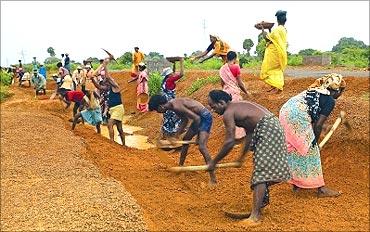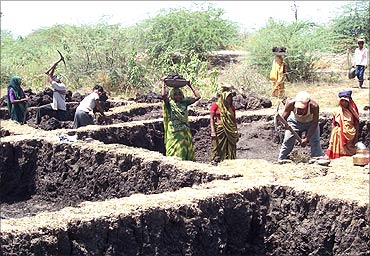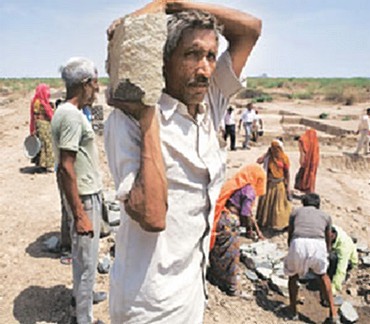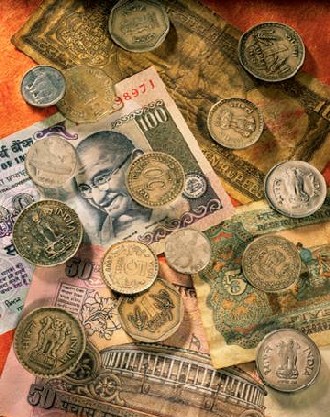 | « Back to article | Print this article |
NREGS: 60% rise in funding possible
The government's biggest welfare programme could see an almost 60 per cent increase in funding.
The forthcoming Budget is likely to make a provision of Rs 64,000 crore (Rs 640 billion) for the Mahatma Gandhi National Rural Employment Guarantee Scheme in 2011-12, against Rs 40,100 crore (Rs 401 billion) in the current fiscal.
The huge increase in outlay will be mainly on account of two factors: Linking wages under the scheme with the consumer price index for agriculture labour; and a marginal increase in the number of working days guaranteed under the programme.
"The calculations also take into account the increase due in the fourth quarter of next year after the existing wages are again indexed to CPI on January 1, 2012.
Click NEXT to read further. . .
NREGS: 60% rise in funding possible
"This indexation will help provide real wages to people in view of rising inflation," a senior government official, who did not wish to identified, told Business Standard.
The ministry of rural development has worked out the expected outlay for the flagship scheme, even before it has finalised its overall funding requirement.
The rural development ministry administers the programme.
MGNREGS constitutes more than half the ministry's outlay.
"Discussions on the ministry's outlay would be finalised in consultation with the Planning Commission in the coming weeks," said the official.
Click NEXT to read further. . .
NREGS: 60% rise in funding possible
With a budget of Rs 40,100 crore (Rs 401 billion), MGRES is the government's biggest welfare spend.
According to the latest figures, the Centre would have disbursed about Rs 25,000 crore (Rs 250 billion) until end January on the programme, against an allocation of Rs 40,100 crore for 2010-11.
About 30 per cent of the total allocation is usually spent in the last quarter.
Starting January 1, 2011, wages under the scheme are linked to Communist Party of India for agriculture workers.
This has put a burden of Rs 4,000 crore (Rs 40 billion) on the exchequer in the current year itself.
"The amount will be adjusted in the provision already made for the current year," said the official.Click NEXT to read further. . .
NREGS: 60% rise in funding possible
The programme is aimed at enhancing livelihood security in rural areas by providing 100 days of guaranteed wage employment every financial year, to every rural household whose adult members volunteer to do unskilled manual work.
The average number of employment days up to December 2010 was 35, which is expected to rise to 45-50 days by March.
The scheme was introduced in February 2005 in 200 districts and has since been extended to all 614 districts.
The total outlay for the programme in 2008-2009 was Rs 16,000 crore (Rs 160 billion).
It more than doubled to Rs 39,100 crore (Rs 391 billion) in 2009-10.
Click NEXT to read further. . .
NREGS: 60% rise in funding possible
It further increased to Rs 40,100 crore in 2010-11.
No other programme has seen such a massive jump in government spending.
With the linking to CPI, wages under the scheme are higher than the minimum wage in 20 states.
Though civil rights groups have been protesting the Central government's decision not to link the two -- there are ongoing court cases in Andhra Pradesh and Karnataka -- the Act governing the scheme gives the Central government discretion to set wages under it.





